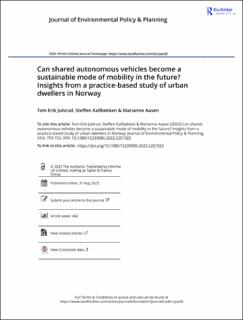Can shared autonomous vehicles become a sustainable mode of mobility in the future? Insights from a practice-based study of urban dwellers in Norway
Peer reviewed, Journal article
Published version

Åpne
Permanent lenke
https://hdl.handle.net/11250/3121276Utgivelsesdato
2023Metadata
Vis full innførselSamlinger
- Journal articles [478]
Originalversjon
10.1080/1523908X.2023.2251923Sammendrag
Shared autonomous vehicles (SAVs) represent a rapidly growing technological field with features believed to potentially support the development of more sustainable mobility systems in city regions. To succeed as a sustainable mode of mobility, however, many current car owners must replace their private vehicles with SAVs. Based on a survey of citizens in Oslo and 12 other Norwegian cities, as well as in-depth interviews with citizens living in a location where SAV is tested, this study explores the relationships between people’s everyday mobility patterns and their future interest in using SAVs. The study located six different mobility practices and found a positive interest in the use of SAVs among people who adhere to a shared mobility type of practice, while the resistance was strongest among people who adhere to different car-based mobility practices. Also, those whose current mobility practice involves the use of electric cars had little interest in replacing their cars with SAVs. The study points to some paradoxes and challenges that are critical to handle if an upscaling of SAVs is to be part of a future sustainable mobility mode.
